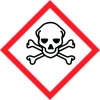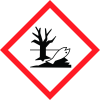Dichlon
Sigma-Aldrich Chemie GmbH
Revision date : 2020-12-17



General Information
Revision date
2020-12-17
Product name
Dichlon
CAS No.
117-80-6
REACH No
is
Emergency telephone
+49 (0)696 43508409
Icons in SDS
Company Information
Company name
Sigma-Aldrich Chemie GmbH
E-mail address of the competent person responsible for the Safety Data Sheet
technischerservice@merckgroup.com
GHS Information
Signal word
Danger
Hazard Codes
Hazard statements (CLP)
H301, H315, H319, H400, H410
Hazard statements
Code
Statements
H301
Toxic if swallowed
H315
Causes skin irritation
H319
Causes serious eye irritation
H400
Very toxic to aquatic life
H410
Very toxic to aquatic life with long lasting effects
Precautionary statements
Code
Statements
P264
Wash ... thoroughly after handling.
P270
Do not eat, drink or smoke when using this product.
P273
Avoid release to the environment.
P301+P310
IF SWALLOWED: Immediately call a POISON CENTER/doctor/...
P302+P352
IF ON SKIN: wash with plenty of water.
P305+P351+P338
IF IN EYES: Rinse cautiously with water for several minutes. Remove contact lenses if present and easy to do - continue rinsing.
Section 2
2.1 Classification of the substance or mixture
Classification
2.2 Label elements
Labelling
Signal word
Danger Danger
Hazard statements
H301 Toxic if swallowed. H315 Causes skin irritation. H319 Causes serious eye irritation. H410 Very toxic to aquatic life with long lasting effects. Reduced Labeling (<= 125 ml) H301 Toxic if swallowed.
Precautionary statements
P264 Wash skin thoroughly after handling. P270 Do not eat, drink or smoke when using this product. P273 Avoid release to the environment. P301 + P310 IF SWALLOWED: Immediately call a POISON CENTER/ doctor. P302 + P352 IF ON SKIN: Wash with plenty of water. P305 + P351 + P338 IF IN EYES: Rinse cautiously with water for several minutes. Remove contact lenses, if present and easy to do. Continue rinsing. P264 Wash skin thoroughly after handling. P270 Do not eat, drink or smoke when using this product. P301 + P310 IF SWALLOWED: Immediately call a POISON CENTER/ doctor.
Supplemental label elements
none none
2.3 Other hazards
This substance/mixture contains no components considered to be either persistent, bioaccumulative and toxic (PBT), or very persistent and very bioaccumulative (vPvB) at levels of 0.1% or higher.

